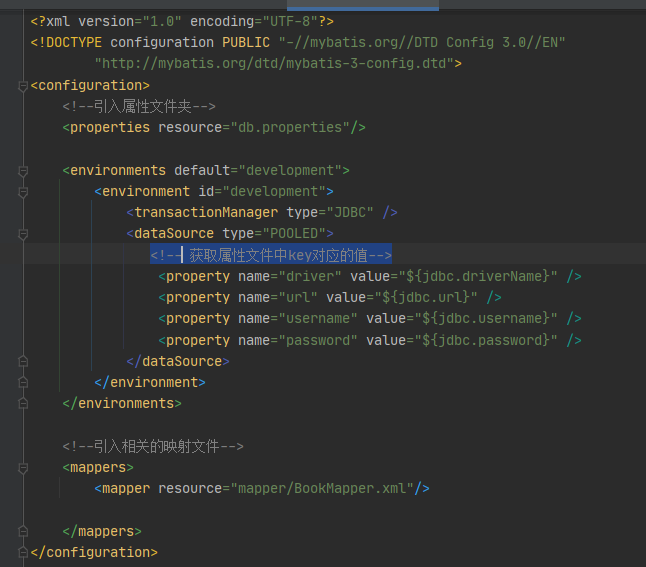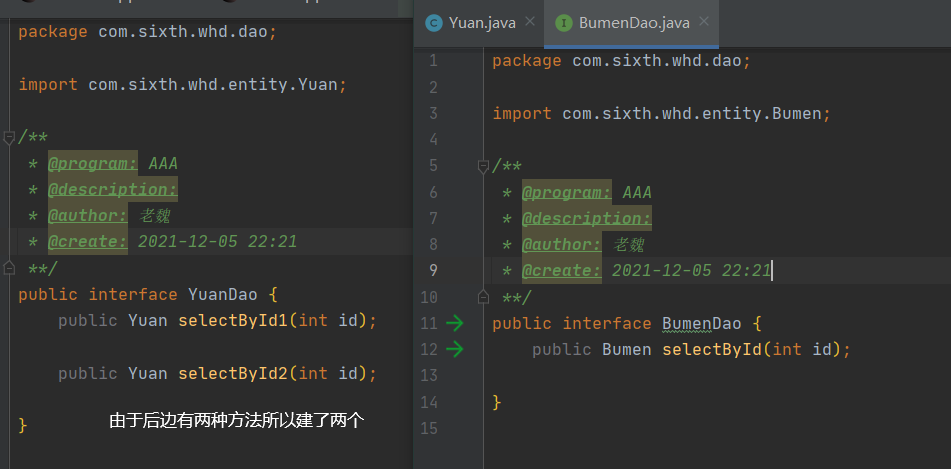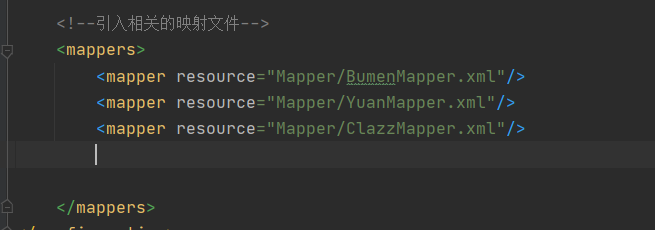目录
1.实际开发中Dao包的使用
2. 传递多个参数。
3. 特殊字符
4. mybatis的优化
4.3 解决列名和属性名不一致。
6.链表查询
7. 动态sql语句。
1.实际开发中Dao包的使用
//为了查找你的sql 需要指定该sql的唯一标识。namespace+id
//所有的方法名都叫做:selectList selectOne() 我们习惯自己命名方法。getById()
也可以自己定义方法
(1)定义一个相关的接口
import java.util.List;
/**
* @program: xxx
* @description:
* @author: 老魏
* @create: 2021-12-05 21:13
**/
public interface BookDao {
public int InsertBook(Book book);
public int updateBook(Book book);
public int deleteBook(int id);
public Book selectById(int id);
public List<Book> selectAll();
}(2)映射文件(
<?xml version="1.0" encoding="UTF-8" ?>
<!DOCTYPE mapper PUBLIC "-//mybatis.org//DTD Mapper 3.0//EN"
"http://mybatis.org/dtd/mybatis-3-mapper.dtd">
<!--namespace:命名空间:它的值现在可以随便写。
以后必须和dao接口对应。
-->
<mapper namespace="a"> //这个现在可以随便起名,到后边就要按照路径写了
<!--这里的id必须和Dao中的方法名一致。-->
<!--增-->
<insert id="InsertBook">
insert into book_info(book_name,book_author,book_price,book_pub) values (#
{name},#{author},#{price},#{pub})
</insert>
<!--删-->
<delete id="deleteBook">
delete from book_info where book_id=#{id}
</delete>
<!--改-->
<update id="updateBook">
update book_info set book_name=#{name} ,book_author=#{author},book_price=#{price},book_pub=#{pub} where book_id=#{id};
</update>
<!--全查-->
<select id="selectAll" resultType="com.sixth.entity.Book"">
select * from book_info
</select>
<!--根据id查-->
<select id="selectById" resultType="com.sixth.entity.Book"">
select * from book_info where id=#{id}
</select>
</mapper>注意: namespace必须和接口所在的路径对应。id必须和方法名一致
(3)测试
import com.aaa.sixth.whd.dao.BookDao;
import com.aaa.sixth.whd.entity.Book;
import org.apache.ibatis.io.Resources;
import org.apache.ibatis.session.SqlSession;
import org.apache.ibatis.session.SqlSessionFactory;
import org.apache.ibatis.session.SqlSessionFactoryBuilder;
import org.junit.Before;
import org.junit.Test;
import java.io.Reader;
import java.util.List;
/**
* @program: xxx
* @description:
* @author: 老魏
* @create: 2021-12-05 21:15
**/
public class TestBookDao {
private SqlSession session;
@Before
public void before()throws Exception{
Reader reader = Resources.getResourceAsReader("mybatis.xml");
SqlSessionFactory build = new SqlSessionFactoryBuilder().build(reader);
session=build.openSession();
}
@Test
public void testInsert(){
//得到dao的实现类。由mybatis框架按照映射文件帮你生成
BookDao bookDao = session.getMapper(BookDao.class);
Book book = new Book();
book.setName("老人的故事");
book.setAuthor("老人");
book.setPrice(50);
book.setPub("xx出版社");
bookDao.InsertBook(book);//调用就是dao中自己的方法。
session.commit();
}
@Test
public void testUpdate(){
BookDao bookDao = session.getMapper(BookDao.class);
Book book = new Book();
book.setName("西游");
book.setAuthor("老刘");
book.setPrice(50);
book.setPub("xxx");
book.setId(1006);
bookDao.updateBook(book);
session.commit();
}
@Test
public void testDelete(){
BookDao bookDao = session.getMapper(BookDao.class);
bookDao.deleteBook(1005);
session.commit();
}
@Test
public void selectById(){
BookDao bookDao = session.getMapper(BookDao.class);
Book book =bookDao.selectById(1007);
System.out.println(book);
}
@Test
public void selectAll(){
BookDao bookDao = session.getMapper(BookDao.class);
List<Book> list=bookDao.selectAll();
System.out.println(list);
}
}
2. 传递多个参数。
<!--如果方法传递的是多个参数时默认mybatis会给这些参数起名:param1 param2.....
<select id="selectByCondition" resultType="com.aaa.sixth.whd.entity.Book">
select * from book_info where name=#{param1} and price=#{param2}
</select>
如果使用自定义参数名 @Param("参数名")
public List<Book> select01(@Param("min") int min,@Param("max") int max);
-->
<select id="select01" resultType="com.aaa.sixth.whd.entity.Book">
<![CDATA[select*from book_info where #{min}>book_price and #{max}<book_price]]>
</select>
3. 特殊字符

解决的方法有两种
(1)使用转移字符(这种方法会难记点,因为每个符号就要多记一个)


2)使用<![CDATA[ 特殊字符或SQL语句 ]]>

4. mybatis的优化
4.1 引入db属性文件。
(1)定义一个数据库属性文件. properties

jdbc.url=jdbc:mysql://localhost:3306/mybatis?serverTimezone=Asia/Shanghai
jdbc.driverName=com.mysql.cj.jdbc.Driver
jdbc.username=root //这个是你的数据库用户名
jdbc.password= //这个是你的数据库密码,由于我没有设所以是空(2)在mybatis配置文件中引入属性文件并使用相应的key

4.2引入日志文件。
(1)引入日志jar包(你可以按自己的喜好来选择版本)
<dependency>
<groupId>log4j</groupId>
<artifactId>log4j</artifactId>
<version>1.2.17</version>
</dependency>(2)引入日志的配置文件 log4j.properties
### 设置###
log4j.rootLogger = debug,stdout,D,E
### 输出信息到控制抬 ###
log4j.appender.stdout = org.apache.log4j.ConsoleAppender
log4j.appender.stdout.Target = System.out
log4j.appender.stdout.layout = org.apache.log4j.PatternLayout
log4j.appender.stdout.layout.ConversionPattern = [%-5p] %d{yyyy-MM-dd HH:mm:ss,SSS} method:%l%n%m%n
### 输出DEBUG 级别以上的日志到=E://logs/error.log ###
log4j.appender.D = org.apache.log4j.DailyRollingFileAppender
log4j.appender.D.File = D://logs/log.log
log4j.appender.D.Append = true
log4j.appender.D.Threshold = DEBUG
log4j.appender.D.layout = org.apache.log4j.PatternLayout
log4j.appender.D.layout.ConversionPattern = %-d{yyyy-MM-dd HH:mm:ss} [ %t:%r ] - [ %p ] %m%n
### 输出ERROR 级别以上的日志到=E://logs/error.log ###
log4j.appender.E = org.apache.log4j.DailyRollingFileAppender
log4j.appender.E.File =D://logs/error.log
log4j.appender.E.Append = true
log4j.appender.E.Threshold = ERROR
log4j.appender.E.layout = org.apache.log4j.PatternLayout
log4j.appender.E.layout.ConversionPattern = %-d{yyyy-MM-dd HH:mm:ss} [ %t:%r ] - [ %p ] %m%n(3)测试

4.3 解决列名和属性名不一致。
(1)为查询的列起别名;让别名和属性名一致。

(2) 使用resultMap标签 来完成属性和列的映射关系。
<!--
id:唯一标识
type: 类型 ; 表与哪个实体类的映射
<id 主键的映射关系 column="列名" property="属性名"/>
<result 普通字段/>
autoMapping=true 表示自动映射。默认true
-->
<resultMap id="My01" type="com.aaa.sixth.whd.entity.Book">
<id property="id" column="book_id"/>
<result property="name" column="book_name"/>
<result property="author" column="book_author"/>
<result property="price" column="book_price"/>
<result property="pub" column="book_pub"/>
</resultMap>
<insert id="InsertBook">
insert into book_info(book_name,book_author,book_price,book_pub) values (#{name},#{author},#{price},#{pub})
</insert>6.链表查询
6.1多对一
(1) 根据员工id查询部门信息以及该部门对应的用户信息。
第一种方式 通过链表查询。
新建员工跟部门实体类

然后新建他们两个的接口(建立接口的时候要注意不要建错了)


接下来还是在resources下建立mapper文件,在里边建立我们所需要的文件()

在测试之前需要去我们的mybatis.xml里把映射文件加进去

接下来就是全部的代码了
<?xml version="1.0" encoding="UTF-8" ?>
<!DOCTYPE mapper PUBLIC "-//mybatis.org//DTD Mapper 3.0//EN"
"http://mybatis.org/dtd/mybatis-3-mapper.dtd">
<mapper namespace="com.sixth.whd.dao.YuanDao">
<resultMap id="My01" type="com.sixth.whd.entity.Yuan">
<id property="y_id" column="yid"/>
<result property="y_name" column="yname"/>
<result property="ID" column="id"/>
<!--association:表示多对一
property:表示对象属性名
javaType:表示该对象所属的类型
autoMapping必须写
-->
<association property="bumen" javaType="com.sixth.whd.entity.Bumen" autoMapping="true">
<!--User和User表的对应关系-->
<id column="bid" property="bid"/>
</association>
</resultMap>
<!--注意:使用了resultMap不能在使用resultType-->
<select id="selectById1" resultMap="My01">
select * from yuangong y join bumen b on y.id=b.bid where y.id=#{ID}
</select>第二种方式是通过嵌套查询。--两次查询

6.2一对多(其实跟多对一差不多,就是等于你把多对一逆向想一下)
根据班级id查询班级信息以及该班级下所有的学生信息。
<?xml version="1.0" encoding="UTF-8" ?>
<!DOCTYPE mapper PUBLIC "-//mybatis.org//DTD Mapper 3.0//EN"
"http://mybatis.org/dtd/mybatis-3-mapper.dtd">
<mapper namespace="com.sixth.whd.dao.ClazzDao">
<resultMap id="Ma01" type="com.sixth.whd.entity.Clazz">
<id column="id" property="id"/>
<result property="cname" column="cname"/>
<collection property="stu" ofType="com.sixth.whd.entity.Stu" autoMapping="true">
<id property="sid" column="sid"/>
<result property="sname" column="sname"/>
<result property="age" column="age"/>
<result property="cid" column="cid"/>
</collection>
</resultMap>
<select id="selectById" resultMap="Ma01">
select *from class c join stu s on c.id=s.cid where c.id=#{id}
</select>
</mapper>7. 动态sql语句。
sql语句根据条件而发生改变。

创建实体类与接口

编写BookMapper.xml文件,由于我写一块了所以就不分开发mapper文件了
<?xml version="1.0" encoding="UTF-8" ?>
<!DOCTYPE mapper PUBLIC "-//mybatis.org//DTD Mapper 3.0//EN"
"http://mybatis.org/dtd/mybatis-3-mapper.dtd">
<mapper namespace="com.sixth.whd.dao.BookDao">
<resultMap id="M01" type="com.sixth.whd.entity.Book">
<id property="id" column="book_id"/>
<result property="name" column="book_name"/>
<result property="author" column="book_author"/>
<result property="price" column="book_price"/>
<result property="pub" column="book_pub"/>
</resultMap>
<!-- 修改部分列的值。
set 可以帮你添加set关键字 并且取出最后的逗号。-->
<update id="update">
update book_info
<set>
<if test="name!=null and name!=''">
book_name=#{name}
</if>
<if test="author!=null and author!=''">
book_author=#{author}
</if>
<if test="price!=null and price!=''">
book_price=#{price}
</if>
<if test="pub!=null and pub!=''">
book_pub=#{pub}
</if>
</set>
</update>
<delete id="batchDelete" >
delete from book_info where book_id in
<foreach collection="ids" item="id" open="("close=")" separator=",">
#{id}
</foreach>
</delete>
<select id="ByCondition" resultMap="M01" >
select * from book_info
<where>
<if test="bookname!=null and bookname!=''">
and book_name=#{bookname}
</if>
<if test="author!=null and author!=''">
and book_author=#{author}
</if>
</where>
</select>
<select id="ByCondition2" resultMap="M01">
select * from book_info
<where>
<choose>
<when test="bookname!=null and bookname!=''">
and book_name=#{bookname}
</when>
<when test="author!=null and author!=''">
and book_author=#{author}
</when>
<otherwise>
and book_price>35
</otherwise>
</choose>
</where>
</select>
</mapper>(1)if和where一起用
<!--如果传入了书名 则按照书名进行查询 如果没有传入书名 则查询所有
where:可以帮你添加where关键 并且把第一个and | or去除
-->
<select id="findByCondition" resultMap="map">
select * from book_info
<where>
<if test="bookname!=null and bookname!=''">
and book_name=#{bookname}
</if>
<if test="author!=null and author!=''">
and book_author=#{author}
</if>
</where>
</select>测试:
@Test
public void testSelect01(){
BookDao bookDao = session.getMapper(BookDao.class);
Map<String,Object> map=new HashMap<String,Object>();
map.put("bookname1","仙人转");
map.put("author","仙人");
List<Book> list = bookDao.findByCondition(map);
}(2) [choose when otherwise] 和where
<!--choose +where
when:当条件满足时不会执行下面的when和other 都不满足则执行otherwise
-->
<select id="findByCondition2" resultMap="map">
select * from book_info
<where>
<choose>
<when test="bookname!=null and bookname!=''">
and book_name=#{bookname}
</when>
<when test="author!=null and author!=''">
and book_author=#{author}
</when>
<otherwise>
and book_price>35
</otherwise>
</choose>
</where>
</select>测试:
@Test
public void testSelect02(){
BookDao bookDao = session.getMapper(BookDao.class);
Map<String,Object> map=new HashMap<String,Object>();
// map.put("bookname","西游");
// map.put("author","老久");
List<Book> list = bookDao.findByCondition2(map);
}(3)set标签。修改部分字段。
<!--修改部分列的值。
set 可以帮你添加set关键字 并且去除最后的逗号。
-->
<update id="update">
update book_info
<set>
<if test="name!=null and name!=''">
book_name=#{name},
</if>
<if test="author!=null and author!=''">
book_author=#{author},
</if>
<if test="pub!=null and pub!=''">
book_pub=#{pub},
</if>
<if test="price!=null">
book_price=#{price},
</if>
</set>
where book_id=#{id}
</update>测试:
@Test
public void testUpdate(){
BookDao bookDao = session.getMapper(BookDao.class);
Book book=new Book();
book.setAuthor("老人");
book.setName("l老人与海");
book.setId(1002);
bookDao.update(book);
session.commit();
}(4) foreach 批量删除。
<delete id="batchDelete">
delete from book_info where book_id in
<foreach collection="ids" item="id" open="(" close=")" separator=",">
#{id}
</foreach>
</delete>测试:
@Test
public void testUpdat2e(){
BookDao bookDao = session.getMapper(BookDao.class);
int [] ids={1001,1002,1003};
bookDao.batchDelete(ids);
session.commit();
}最后
以上就是羞涩睫毛膏最近收集整理的关于Mybatis入门021.实际开发中Dao包的使用2. 传递多个参数。3. 特殊字符4. mybatis的优化6.链表查询7. 动态sql语句。的全部内容,更多相关Mybatis入门021.实际开发中Dao包的使用2.内容请搜索靠谱客的其他文章。








发表评论 取消回复